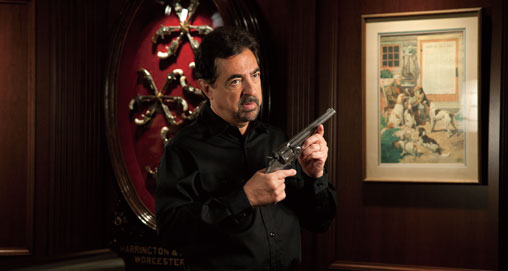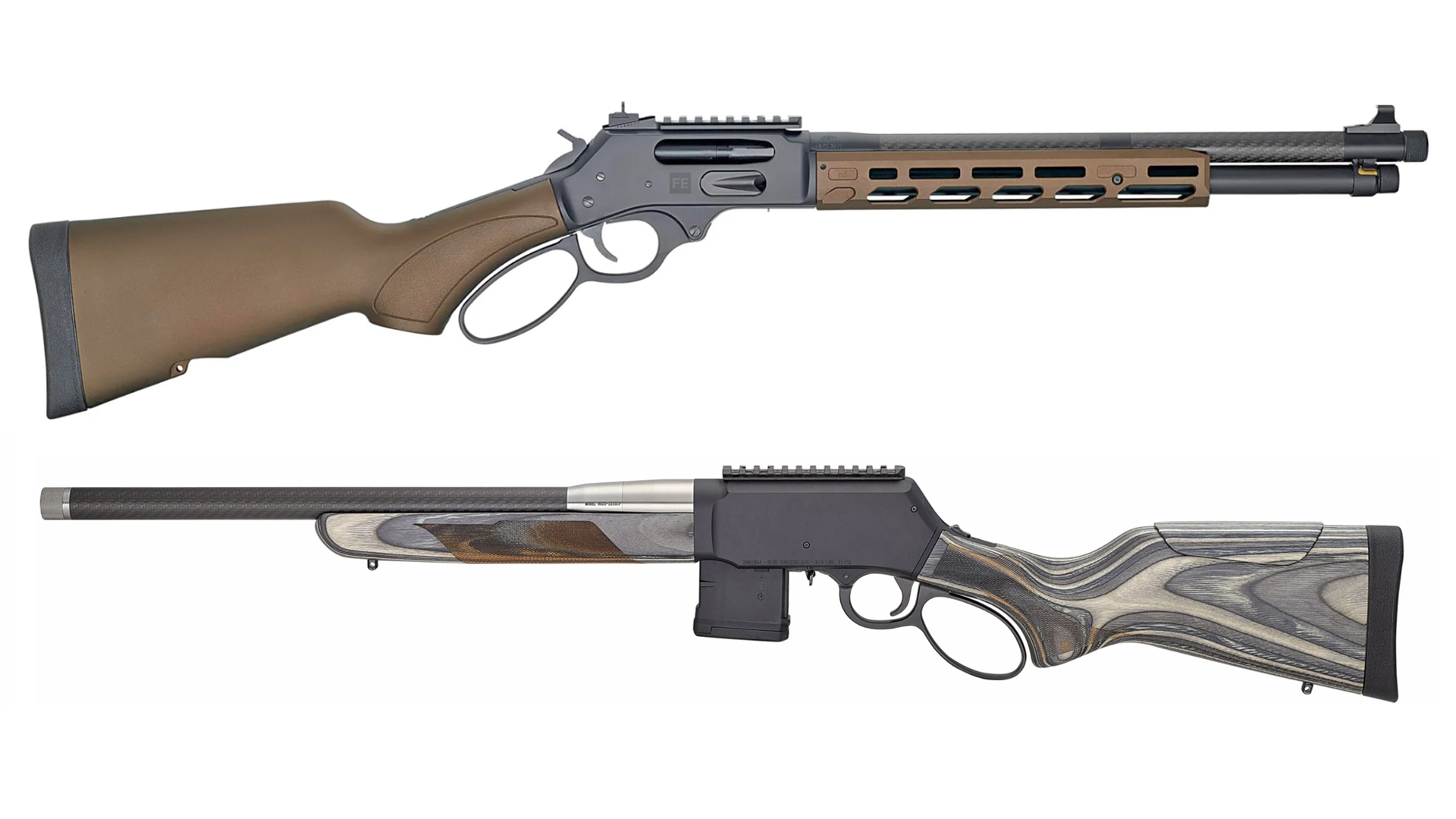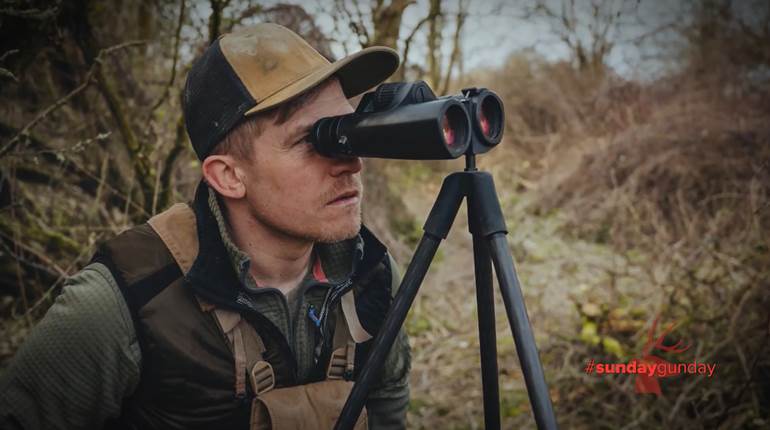
When I told my teenage son that I was going to interview Emmy-nominated and Tony-award-winning actor, producer and writer Joe Mantegna, the first words out of his mouth were, “Hey, isn’t he Fat Tony on ‘The Simpsons’?”
Yes, indeed he is, but Joe Mantegna is also one of Hollywood’s hardest working actors with stage work, film credits and television roles stretching back to the 1960s—including “The Godfather Part III”—and he has a voiceover role in the just-released “Cars 2.” Mantegna is also a gun guy, a shooter who enjoys sporting clays and used to actively compete in IPSC, and a reloader. He was a friend of past NRA President Charlton Heston and even chaired the celebrity shoot named in Heston’s honor.
Mantegna recently visited the National Firearms Museum while filming a new show for the Outdoor Channel he is hosting in the fall—“Gun Stories.” Between takes, I was fortunate enough to interview the actor, who plays David Rossi on CBS’s “Criminal Minds,” and it turns out that Mantegna is extremely personable, genteel and has a genuine passion for shooting, firearms, history and freedom.
Keefe: Thanks for being with us, Joe. Please start off by telling us how you got interested in shooting.
Mantegna: Well, it’s funny. I grew up in a really urban kind of existence. In other words, I grew up in the city of Chicago and always lived in apartments, so it probably was not the most conducive place to be exposed to firearms. But my dad grew up on a farm, and he used to tell me stories about how you had to learn to shoot at a very young age and how firearms were a big part of daily life. This was interesting and intriguing to me, yet somewhat foreign.
I really had no kind of outlet until I was in my late teens. There was a terrific gun club located right on Lake Michigan in the city of Chicago that had been established sometime in the ’30s. Actually, I think it might have even been a WPA project before the war. There was a bike path that used to go right by it, and I used to ride that path a lot when I was 18 or 19. I’d stop and I would just put my arms up on the fence and watch these guys shoot skeet and trap right over the lake. It was the most beautiful thing in the world to me because the place was built of old logs. There was the Chicago skyline in the background and the lake, and you’re seeing these clay birds flying and being blown up. I just thought, “This is spectacular.”
One day, one of the guys happened to walk by the fence, saw me, and said: “Hey, so you just gonna watch or you gonna shoot?” I said, “Look, I don’t shoot, I’m just watching you guys shoot.” He said, “Well, come on, I think you should learn about this.” Turned out he was the president of the gun club and asked me to come in. The next thing I know, he’s got a shotgun in my hands and gives me a big bag of shells, and then he says, “OK, here’s how you shoot skeet.” And, of course, after one round of skeet —I maybe busted six or seven—I was hooked.
That was it. I couldn’t wait to get my own shotgun. So it was the best possible way of being introduced to the shooting sports—by somebody who really understood it, somebody who was a real advocate and somebody who really did it the right way.
I got into pistol shooting basically due to acting. I was cast into a play where I had to do a fairly extensive scene where there was some gunplay. I felt I needed to know what I was doing, so I went out with some real professionals, got instruction and really learned the right way to handle handguns. So between learning handguns for the play and picking up shotgun shooting from those guys at the gun club in Chicago, that did it for me. That put me on the path I’ve been following for over 40 years now.
Keefe: Of all the shooting sports you have tried, what do you enjoy shooting most now?
Mantegna: I probably enjoy shotgun shooting the most right now. I’ve really gotten into sporting clays. Once I discovered skeet, it was what I primarily did. And I did some trap shooting. But most of the shotguns I acquired were designed for skeet. But then I was introduced to sporting clays, and I thought: “Wow, here’s the best of all worlds.” You know, here was golfing with a shotgun. So sporting clays to me is just the premier kind of shotgun shooting. You’re out, usually, in some interesting locale, and each station has got its own kind of variety. You can be shooting out of a rocking rowboat or shooting “rabbits,” so I really enjoy that. I did a lot of pistol shooting back in the ‘70s, including some competitive shooting and practical pistol shooting.
Keefe: That leads me into my next question. I noticed your gun handling on screen. Unlike that of many other actors, it’s always safe and proficient. Do you work at that?
Mantegna: I work at it to the extent that it should be second-nature. My feeling is if I’m going to play a character who is a professional, he would be proficient, and he would know what he’s doing. Gun safety, first of all, is so important. It’s paramount to everything we do in the shooting sports, and it’s always the first thing you have to learn and always be aware of. I always enjoy working with people who make that the prime consideration.
I remember an episode of the old “Miami Vice” series, in which one character winds up in a shootout. I know producer Mike Mann has a real interest in the shooting sports, and Mike hired a dear friend of mine named Jim Zubienna, who’s an actor. This guy had won many, many practical pistol shooting awards over the years. He’s the guy that actually got me into pistol shooting. The only reason Mann hired Zubienna was because he was such a fast draw. That sequence of “Miami Vice” was like watching Tiger Woods golf, or Joe DiMaggio play baseball, he drew and fired so quickly. If you’re going to see somebody compete in a certain arena, it’s always nice to see the people who do it best, to learn from them, be able to witness them.
When I do use a firearm on some theatrical or movie piece, I certainly try to make it as realistic as possible, showing the proper ways of doing it so people don’t say, “Wow that’s weird, you wouldn’t think a guy would walk around like that with a gun.” It always drives me crazy when I see that.
Keefe: I’ve seen that you try to build shooting as a sport into the story line on your shows. I think it was in your opening scene of “Criminal Minds” that you made your debut with a shotgun in your hands. Also, you worked the Second Amendment into “First Monday.”
Mantegna: I’ve incorporated it into a few shows. On “Criminal Minds” in my very first episode, they actually introduced my character by having a duck fly across the sky, and all of a sudden, “Boom!” You see the duck fall, and then the camera cuts to me in a blind with my dogs. My cell phone rings, I pick it up, and it’s my superior at the FBI. I tell her, “Yes, that’s right, I’m coming back.” That’s how my character was introduced, and I thought that was a great way to set the tone.
“First Monday,” in which I played a Supreme Court justice, due to—partly—my input, we actually did an episode that dealt with the Second Amendment and the issues surrounding it. I remember thinking at the time, “Wow, this is pretty good,” because it was one of the few times when on network television they actually handled the issue fairly intelligently. It had my judge character coming out on the side of the Second Amendment, and it gave me a chance to explain why I felt that way.
As we all know, sometimes Hollywood gets that reputation of being slanted only in the anti-gun direction. This was a case in which I think the producer of the show felt as I did. He was a former Marine, and we both thought to give it a shot—we’re not trying to sell anybody one thing versus another, but let’s at least be fair about it and show that there can be a divergence of opinion. Some on the Supreme Court would feel one way about it, I wanted my character to feel the other way, and I thought it was really well done in that it showed both sides of the issue.
Keefe: Currently you and Tom Selleck are among the most famous shooters in Hollywood. Despite your success on “Criminal Minds” and his success on “Blue Bloods,” do you think it’s been harder for you guys to succeed in Hollywood because of your beliefs?
Mantegna: I think if we both looked at our careers it would be funny for us to say, “Oh yeah, we really suffered.” I mean we’re both doing fairly well. I think that’s why it’s important for us to be vocal about how we feel. Perhaps others have, and maybe stating my feelings helps the next generation.
What’s ironic and funny is, if you take the landscape of show business—especially dramatic programming—it seems like 90 percent of it deals with firearms anyway. On all of these shows, the procedural shows, everybody’s got a gun. But yet you’ll hear comments like, “Well, you know we feel this way about firearms.” Wait a minute, you can’t talk out of both sides of your mouth; you can’t use guns as a symbol of what you’re basically trying to sell, yet on the other hand be critical of them. If you make the choice, “Look, I just don’t want to own one, I don’t like shooting them,” that’s your choice, and that’s fine. That’s why we live in the country we do. We have a Second Amendment and a First Amendment. So it’s the same, it’s a freedom, not a requirement.
Keefe: Joe, you’re in town filming for “Gun Stories,” which is slated to debut in the third quarter, on the Outdoor Channel. Tell me about the show.
Mantegna: Well, we’ll be covering the historical significance of certain firearms. In the initial season, we’ve picked 12 firearms that have their own definitive place in the history of firearms. We basically tell the story of each, trace its history and get into every aspect of it: why it’s had such significance, what were its origins, what’s its place in the world, where is it today, where is it going and whether it’s still around. The title is right, “Gun Stories.” It’s the story of that particular firearm, each episode, and it’s being done thoroughly in an interesting, provocative kind of way. This is our first season, and if it goes well we’ll expand. As we go along, we’re even getting more ideas. But it’s great, because I think what’s important, too, is that we’re wanting to break the stereotype—not even the stereotype—but sometimes the mythical feeling people who have never been exposed positively to firearms have. The very word “gun” is a hot button word.
It’s wrong to be afraid of a word, and the only way to overcome the fear of the word is through understanding. Of course, a gun should be respected as it has a certain innate power as a tool, as would a chainsaw or a car or anything else. But to overcome the inerrant fear of the word, you have to understand it, and that’s why education is so important.
It all comes out of education and understanding. At the end of the day, form your own opinion. When it’s all said and done you say, “I still don’t like to do it, but I respect your right to it.” That’s all any of us are asking for. Just understand it and make your decision.
Keefe: What’s your favorite gun?
Mantegna: I guess we’d have to break it down into categories. For a handgun? No question. It would be the M1911. That wasn’t the very first handgun I shot, but it was the one I ultimately used competitively. I just enjoy the caliber, I’ve shot pretty much every handgun caliber you can think of, and the .45 ACP is perfect. It has mass, the recoil is a little more, you get a lot of push, but you don’t get a lot of torque. And it’s just the aesthetics of it—it’s old school—it’s what I carry on “Criminal Minds.” I made that choice as I thought this guy would be old-school and this would be the firearm he would carry. The M1911 is classic. I think it’s the first one we’re doing in our series “Gun Stories.”
If I’m going to get into shotguns, I really love over-unders. Being Italian, I’m partial to the Italians. I own a few Berettas, but I aspire to own others, other things that end in a vowel—Perazzi comes to mind. There’s nothing like a beautifully made shotgun. My first shotgun was a Remington Model 1100, which is a classic, of course, but nothing can beat a beautifully made over-under. I have a few different gauges, some Rugers and some other brands, but I’ve mostly been shooting Beretta.
In rifles, I like the old cowboy stuff—I mean Model 1894s and other lever-actions, .30-30s—even those that shoot pistol calibers like .357 and .44 Magnum. I have a Marlin 1894C. I enjoy that as well.
But again, that’s the thing about firearms; it’s kind of like wine or cigars. There’s such a diverse variety of the things you can get as involved in as much as you like or not. I used to do a lot of reloading, and even that, that’s a whole other thing, a whole other aspect of it. It’s interesting.



















![Auto[47]](/media/121jogez/auto-47.jpg?anchor=center&mode=crop&width=770&height=430&rnd=134090788010670000&quality=60)
![Auto[47]](/media/121jogez/auto-47.jpg?anchor=center&mode=crop&width=150&height=150&rnd=134090788010670000&quality=60)
















